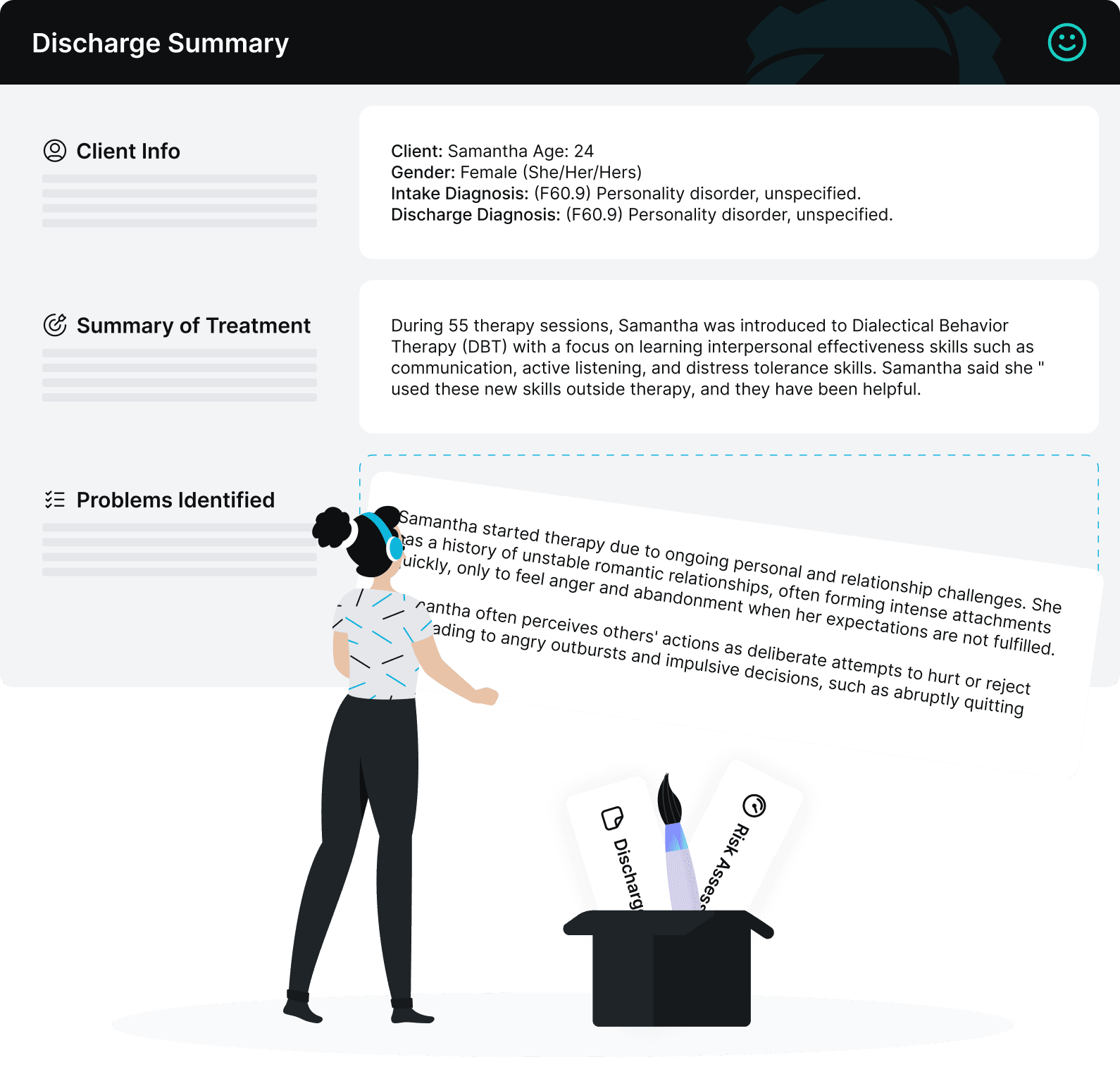Discharge Summary
The Discharge Summary provides a structured format for summarizing a patient’s care journey, treatment outcomes, and recommendations for follow-up care. It ensures a comprehensive and clear overview of the patient’s status at discharge, facilitating seamless transition and continuity of care.

AI Discharge Summary Template & Examples
Enhancing EMDR Notes with AutoNotes
The advent of Artificial Intelligence (AI) in healthcare has been transformative, offering unprecedented advancements in clinical documentation, diagnostics, and patient care management. Among the myriad applications, AI’s role in streamlining and enhancing clinical documentation, particularly for specialized therapeutic practices like Eye Movement Desensitization and Reprocessing (EMDR), stands out as a critical development. This article explores how AI tools, especially AutoNotes, are revolutionizing the way therapists generate EMDR notes—making the process more efficient, accurate, and effective.
Understanding EMDR and Clinical Documentation Challenges
EMDR is a psychotherapy treatment designed to alleviate the distress associated with traumatic memories. It involves an eight-phase treatment approach that uses the patient’s own rapid, rhythmic eye movements to dampen the power of emotionally charged memories of past traumatic events. Clinical documentation in EMDR, as in other therapeutic fields, is crucial for tracking patient progress, planning treatment, and ensuring continuity of care. However, the complexity of EMDR sessions, which involve recalling emotional trauma and monitoring patient responses, can make thorough documentation challenging and time-consuming.
The Role of AI in Clinical Documentation
AI in clinical documentation helps address several challenges faced by healthcare providers today. It offers tools that automate the creation of detailed, compliant, and personalized medical notes. By reducing the administrative burden on healthcare professionals, AI enables them to focus more on patient care rather than paperwork. For EMDR therapy, where details about the patient’s emotional and physiological responses are crucial, AI-enhanced tools like AutoNotes can ensure that no critical information is missed.
AutoNotes: A Game Changer for EMDR Documentation
AutoNotes stands out as a premier AI productivity tool specifically designed to support the generation of EMDR notes. With its advanced algorithms and user-friendly interface, AutoNotes simplifies the process of documenting complex therapy sessions by providing structured templates that therapists can easily customize and fill during or after sessions.
Key Features of AutoNotes for EMDR Therapy:
- GIRP Format Adaptation: AutoNotes supports the GIRP (Goal, Intervention, Response, and Plan) note format, which is particularly suited to EMDR documentation. This format helps therapists systematically capture the essence of each session, including goals, interventions, patient responses, and future plans.
- Customizable Templates: Therapists can create and modify templates based on the specifics of their EMDR practice. Whether it’s adjusting the template to include specific scales like the Subjective Units of Disturbance Scale (SUDs) or adding fields for new techniques, AutoNotes offers flexibility.
- Automated Data Entry: By using presets based on common EMDR scenarios, therapists can quickly populate notes with repetitive data, reducing the time spent on each note. This feature is particularly useful in documenting standard procedures or typical responses.
- Enhanced Accuracy and Compliance: AutoNotes ensures that all documentation complies with healthcare standards, including HIPAA in the United States. The AI also helps reduce human errors, which can be crucial when dealing with sensitive mental health records.
How to Write an EMDR Note with AI in AutoNotes
Writing effective EMDR (Eye Movement Desensitization and Reprocessing) therapy notes is crucial for tracking the progress and outcomes of this specialized treatment. AutoNotes, enhanced with AI capabilities, streamlines this documentation process, ensuring that therapists can create detailed and accurate records efficiently. Here’s a step-by-step guide on how to utilize AutoNotes for crafting EMDR therapy notes:
- Set Up the Session Details: Begin by inputting basic session information into AutoNotes, such as the date, duration, and specific EMDR session phase. This foundational data helps structure the rest of the therapy note.
- Document Client Responses: During the EMDR session, significant client reactions and behaviors should be meticulously noted. While AutoNotes provides an organized framework for capturing this data, therapists need to input specific observations, including the client’s responses to various EMDR stimuli and any noticeable changes in distress levels.
- Record EMDR Techniques Used: Detail the specific EMDR techniques and protocols employed during the session. AutoNotes can structure this information, but the therapist must ensure that the descriptions accurately reflect the techniques used, including any bilateral stimulation or targeting sequences.
- Evaluate Treatment Effectiveness: At the conclusion of the session, assess the effectiveness of the EMDR intervention. AutoNotes offers templates for such evaluations, but the therapist should provide a detailed analysis based on the client’s progress and reactions noted during the session.
- Plan Future Sessions: Based on the outcomes and client’s current state, plan and document next steps or modifications needed for future EMDR sessions. AutoNotes facilitates the planning process with easy-to-use planning tools, but the final treatment direction should be determined by the therapist’s professional judgment.
- Review and Customize the Note: Before finalizing the therapy note, review all entered information for accuracy and completeness. AutoNotes allows for easy customization and editing of the notes, enabling therapists to make necessary adjustments to best represent the session’s events and therapeutic interventions.
- Finalize and Save Notes: Once the EMDR note is completed, you can save it in a folder on AutoNotes or download as a PDF to be stored locally. This ensures consistency and accessibility for future reference, aiding in the ongoing management of the client’s therapeutic journey.
By using AutoNotes to document EMDR sessions, therapists can effectively manage their documentation tasks, allowing them to focus more on the therapeutic process and less on paperwork. The AI-enhanced capabilities of AutoNotes ensure that the documentation is not only quick but also precise and reflective of each session’s unique aspects. This approach highlights the therapist’s essential role in evaluating and adjusting the content of the notes to align with professional standards and specific therapeutic goals.
The Future of AI in EMDR and Beyond
As AI technology continues to evolve, its integration into more specialized areas of healthcare, including EMDR, is expected to deepen. Future developments might include more sophisticated predictive analytics to aid in treatment planning or real-time documentation assistance during therapy sessions.
Looking Ahead: EMDR and AI
AI’s integration into clinical documentation represents a significant step forward in the field of healthcare. For therapists practicing EMDR, tools like AutoNotes not only simplify the documentation process but also enhance the accuracy and utility of clinical notes. As we move forward, the potential for AI to further support and transform healthcare practices remains vast, promising even greater improvements in patient care and treatment outcomes.
AutoNotes makes documentation fast, easy, and stress-free — so you can focus on what matters, your clients.



